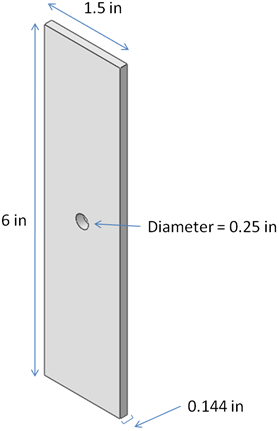Introduction
The model is based on coupon level test results from the National Institute for Aviation Research (NIAR). Specifically, an open-hole tension (OHT) plate made from T700/2510 is built and compared to the experimental results [1] determined by NIAR. The plate layup is [45/0/-45/90]3S and the plate dimensions are given below.

In the following tutorial, elementary modeling details are omitted. It is assumed you have previous experience in the ANSYS Mechanical APDL environment. Please refer to the ANSYS documentation before completing this tutorial if you are unfamiliar with the ANSYS GUI.
If you are interested only in learning how to view results generated by Helius PFA, an ANSYS input file (Tutorial_1_ANSYS.ans) is available for download that can be used to generate an ANSYS results (*.rst) file. In this case, follow the steps in the Characterize a User Material with Composite Material Manager section, then run the input file and refer to the View and Interpret Results section. Before submitting the file for analysis, ensure that the matID values in the input file match the matID for Tutorial_1 (the name assigned to the material created in this tutorial) on your workstation. The matID for Tutorial_1 can be determined by selecting Tutorial_1 in the Helius PFA plug-in within ANSYS as detailed in the Create a User Material with the Helius PFA Plug-in section.